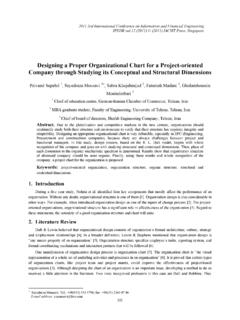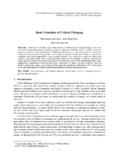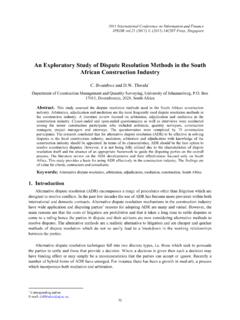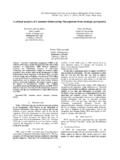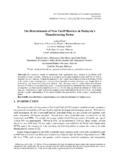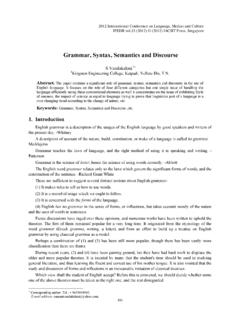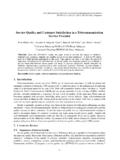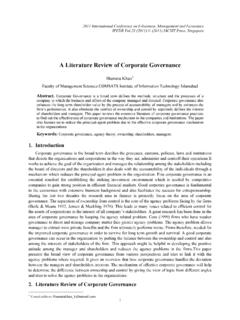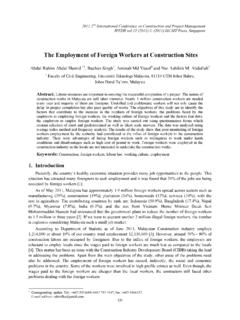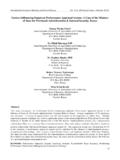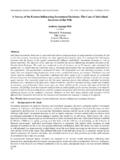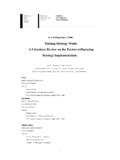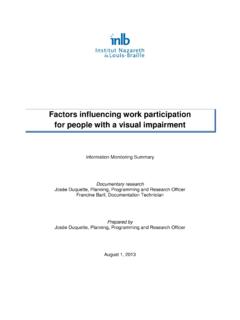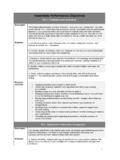Transcription of Identifying the Important Factors Influencing the ...
1 Identifying the Important Factors Influencing the implementation of Succession Planning Shadi Ebrahimi Mehrabani1+, Noor Azmi Mohamad2 1 Department of Computer, Islamic Azad University of Iran, Dehaghan branch 2 Department of Management and Human Resource Development, University Technology of Malaysia Abstract. There are many Factors which cause instability in an organization s workforce. Some of these Factors are illness, retirement, attrition or finding better jobs. Considering this unstable environment and in order to create stability for the future of the organization, they need to hire capable people for key positions. One of the Important tools for attracting, developing, and retaining the talent in the workforce is succession planning. There are many Factors Influencing the implementation of an effective succession planning system in organizations. The main purpose of this qualitative study is to find the most Important ones in Iran s private Banks.
2 The result of interviews with five key executives in five private banks in Esfahan the second largest city in Iran- which all have the succession planning system in their organizations, indicate the Factors as: training, management supports, clarifying the career path, creating a positive vision, strong organizational culture, technology advancement, flat structure and the financial conditions. While the lack of considering these Factors is a threat to the system, the result of this study may help other organizations to consider implementing the succession planning system for better outcomes. Keywords: Succession planning, Effectiveness of Succession Planning, Iran s Private Banks. 1. Introduction Most organizations found that they must rely on their employees as the only way to become stable in this competitive age. Organizations need to develop their employees knowledge, skills, talents and capabilities. Many organizations use succession planning to develop and maintain powerful leadership and other key employees to make sure that they address all the skills and competencies required for the economic environment [1].
3 One of the human resource tools which can help the current and future needs of organizations, is succession planning. Succession planning is a helpful approach to find the appropriate people who are needed for leadership positions or other key positions in the organizations [2]. Haraf (2005) states that, the need for effective succession plans is increasing in the organizations, but many companies and organizations do not pay enough attention to such plans and many of them are facing many challenges and barriers in the process of these programs [3]. 2. Succession Planning In an overall definition, succession planning is a vital structure that takes into account the organization s resources for the maintenance and development of high potential employees [4]. Over the years, many studies conducted in the field of succession planning. However, some researchers believe that beginning research in succession planning issues is related to the early 20th century with the writings of Henri Fayol about the fourteen points of management [5] but succession planning and management as we know it nowadays arrived of age in the late 1960 s and early 1970 s, when formal succession planning methods were adopted by + Corresponding author.
4 Tel.: + 60147353868 E-mail address: 372011 International Conference on Information and Finance IPEDR (2011) (2011)IACSIT Press, Singapore organizations. Some methods which were used in succession planning were estimating the performance and potential of the group of talented employees, planning their movement through the organization, and establishing detailed developmental plans [6]. Historically, organizations only paid attention to replace the employees exactly before they were to leave the organization and the decision about the people who would replace them usually was made by the chief executives or board of directors [7]. The focus was on replacing the employees, not to develop them and in many cases it did cost a lot for the organizations [8]. In fact, in today s dynamic world where competition is high, work is fluid, environment is unpredictable, organizations are flatter, and the organizational configuration frequently changes, the old view of succession planning by defining specific people for the specific job does not work [9].
5 Nowadays, organizations found the alternative way. They discovered that in order to be certain of having proper talents for the future needs, they must train leaders and key employees [10]. Succession planning is used as an essential and strategic tool for the organizations to attract, develop, and retain talent in the workforce [11]. As a comprehensive definition, succession planning can be defined as an attempt to have a plan for the right number and quality of key position employees, including managers to cover retirements, promotions, serious illnesses, death or any new job, which may be created in the future of the organization s plans [12]. 3. Effectiveness of Succession Planning An effective succession planning and management effort must consider the individual s development needs for all job categories [13]. One of the most Important aims of succession-planning program is to maintain talent by keeping employees motivated and engaged.
6 Fulmer and Conger asserted that an effective succession planning system can help talented people to move their tracks faster and more appropriate [14]. There are many Factors which help succession planning system to be successful and effective, even though each organization will be quite unique in its specific features. Some of these Factors explain as follows. At first the executives and top managers should be committed to the concept of succession planning and must support implementation of the system. Staff also, have to support the activities of the plan. In addition, a link between succession planning systems with other human resource systems and activities is needed. Adequate human resources information system is also needed. Moreover, an appropriate organizational structure and job engineering to protect experiential learning is required. Furthermore, organizational commitment for promotion from within is needed as well as training in coaching, mentoring, and giving feedback and other methods in training.
7 Additionally, accountability for implementation of developmental plans should be obviously stated. Evaluation of the system and plan also must be considered in the human resources duties [15]. A main factor which influences the succession planning is the role of human resource development, which includes organizational development, career development and the learning and development of potential successors [12]. Rothwell (2002) explains some practices which can help the success of succession planning efforts. These Factors include: clarifying the aim and the desired results of the effort, determining the requirement of the current performance, measuring the performance, determining the performance which is needed for the future, assessing the potential, establishing a way to narrow the gaps, following up, documenting competence, making and maintaining rewards for developing people, evaluating results and leading from the front [6].
8 4. Benefits and Barriers of Succession Planning Some of the main objectives of succession planning are: developing people to increase their managerial power; recognizing high potential employees and providing them with a developmental opportunity; reducing the time needed to fill management positions; attracting and maintaining individuals who are highly competent. When managers know that organization is committed to develop them using succession planning system, they will work with high morals. Such a system makes it also clear that there are career paths available in the organization [16]. 38 Organizations lose workforce all the time. The workforce might be replaced in a short time, but what they are actually losing is a large quantity of company memory and essential skills. They are not always managers of the company. They might be key employees such as delivery, design, research and production operatives.
9 They are the people with the significant knowledge of problem solving. They are the ones who may know all the faults of the process and may know the operating manuals. They are your critical talent. Therefore, having the succession planning system can help the organization to scramble to fill positions, earn the cost of head-hunters and attitude the financial burden of lower productivity [17]. Planning and applying the succession planning is not an easy process. There might be many barriers and difficulties, which would delay the process and slow it down. These barriers and obstacles to succession planning are different and depend on organizational culture, strategy, and economical conditions. According to Charan In succession, it takes a ton of ore to produce an ounce of gold, very few of your company s leaders will ever be qualified to run the firm [18]. There are many companies, which do not allocate enough time to succession planning.
10 Some of them do not understand the value of it and many organizations are busy with current issues in their business and do not think about the future [19]. Realising the importance of succession planning to classify, select, and develop the future leader would be another barrier when it is not fully to take over as their successor [9]. Sometimes, it is hard to think about the replacement for current managers who spend many years in their position. There are also those who would like to keep their job and not to leave. Some leaders and managers want to keep their position so badly that they only focus on their own needs instead of the organization s [20]. Recognize the barriers which may exist for implementation of a strategic succession planning process will provide a basis for discovering the main concern of resource, notifying the decision making and finding the training needs to implement the strategic plan for the employees [13].

